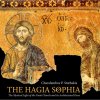Father Stephen Tumbas is on Love, Hope, and Faith on TSPN TV April 1, 2015
A great man is one who collects knowledge the way a bee collects honey and uses it to help people overcome the difficulties they endure - hunger, ignorance and disease!
- Nikola Tesla
Remember, remember always, that all of us, and you and I especially, are descended from immigrants and revolutionists.
- Franklin Roosevelt
While their territory has been devastated and their homes despoiled, the spirit of the Serbian people has not been broken.
- Woodrow Wilson
Latest Articles
- Crafting Pišanice - Serbian Easter Eggs with Natural Dyes
- From Nicaea to Today: The Enduring Legacy of Synodality and Unity in the Church
- The Role of the Deacons in the Church
- The Circle of Serbian Sisters
- Vinka Ellesin
- Богородица као екстатично биће
- Bishop Maxim's Homily During the Assembly of Bishops XII Opening Liturgy
- Leon Joseph Lysaght Jr.
- Olga Gradojevich
People Directory
Бобан Марјановић
Бобан Марјановић (Зајечар, 15. август 1988) је српски кошаркаш. Игра на позицији центра, а тренутно је члан Детроит пистонса. Са 222 cm висине један је од највиших кошаркаша у свим такмичењима у којима наступа.Поред велике висине одликује га изузетна снага, али и мека рука приликом шута, те су му проценти шута споља као слободних бацања веома добри са обзиром да игра на позицији центра. У досадашњој каријери наступао је за: Хемофарм, ЦСКА Москву, Жалгирис, Нижњи Новгород, Раднички Крагујевац, Мега Визуру, Црвену звезду и Сан Антонио спарсе. Три пута је био најкориснији играч Кошаркашке лиге Србије. Двоструки је члан идеалне петорке Јадранске лиге. Четири пута је био МВП кола Евролиге, а проглашен је и за најкориснијег играча прве фазе Евролиге као и члан идеалне петорке у сезони 2014/15. У тој сезони успео је да обори три рекорда у историји Евролиге и то: број остварених дабл-даблова у једној сезони (16), укупан број скокова у једној сезони (256) као и укупан индекс корисности у једној сезони и то 616. Био је део најуспешније генерације у историји Црвене звезде која је успела да освоји триплу круну у сезони 2014/15.
Read more ...Publishing
The Hagia Sophia
The Mystical Light of the Great Church and its Architectural Dress
by Charalambos P. Stathakis
Dear reader, as you run like the rest of us along the dizzy main road, stop, stay aside for a while. Let the others be dizzy, and take the secret underground trail, which will lead you through the dewdrops of the leaves, the crystal smile of the sun, the city’s underground galler- ies, your knowledge, and your feelings, to the doorstep of the Hagia Sophia. Because all dew- drops, all sunrays, and all beauty lead there. That is what you will be told by my friend, the author, whom I am fond of and whom I send you to, Charalambos Stathakis: the doctor, the warm and humane researcher, the scientist devoted to his work and his patients, who has given a series of scientific papers, who, nevertheless, retains a nest of beauty untouched in his heart, which makes him outstanding—even though he is not a specialist in architecture, nor a historian, nor a theologian, nor a Byzantinist—it makes him stand out in all these together and in entirety.
Read more ...Latest US News
- Волт Богданић: Американац српског порекла добитник три Пулицерове награде за истраживачко новинарство
- The American Srbobran - Building a Partnership with the Library of Congress and Institutions in Serbia
- „Американски Србобран“ унапређује сарадњу са Конгресном библиотеком у Вашингтону и институцијама у Србији
- Преминуо чувени амерички песник српског порекла Чарлс Симић
- Јован Дучић међу великанима у кливлендској башти
- Србија, Африка, Америка и Канада славе дан Теслиног рођења
- Документарац Немање Станковића приказан у Холивуду
- Tesla Rhapsody
- Saved by Beauty: Dostoevsky in New York
- Izložba likovnih radova o Dostojevskom
- Steve Popovich - the man who discovered Meat Loaf
- Odlazak čoveka koji je mnogo uradio za očuvanje sećanja na lik i delo Nikole Tesle
- Naš otac Balkanac za Ruse je smislio bijelu Coca-Colu
- Neverovatan poduhvat srpske pravoslavne zajednice u Americi
- Prva Srpkinja u finalu najveće evropske nagrade za pronalazače
Latest Serbia News
- На Станфорд листи 15 крагујевачких научника
- Naše postojanje skriva mračne i svetle strane, i veliko je umeće prepoznati ih i razlučiti
- Српска застава је најлепша на свету – на основу резултата анкете милион људи
- Недеља америчке културе
- Preminuo pisac Aleksandar Petrov
- Spomenik Branku Pešiću radiće srpski vajar iz Los Anđelesa
- Metropolitan Amfilohije buried in the Cathedral church in Podgorica
- Memorial prayer rite for Metropolitan Amfilohije in the Cetinje Monastery
- На данашњи дан рођен је Михајло Идворски Пупин
- Алекса је стигао до Принстона, али Математичкој гимназији се радо враћа
- Каубој православац и 40 Американаца посетили Косово
- Архив Војводине: Сведочанства времена у спомен на херојске претке
- Премијера „Теслиног народа“ на Коларцу
- Када се велики умови играју науком о подацима
- Američka vojska donirala je vrednu opremu klinici u Nišu




